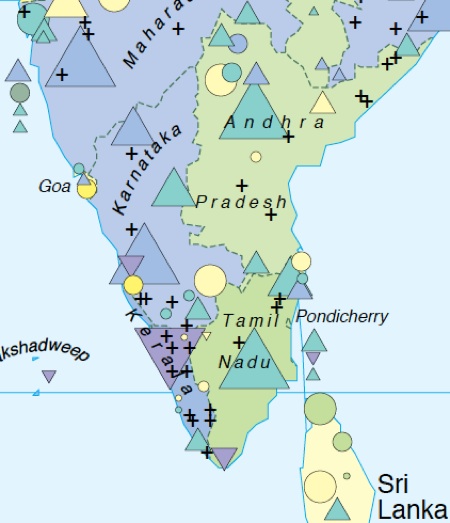Household and Family
Type of Family and Household
The family/household map addresses the question of who lives with whom in what place: Are single-person households the rule? Do siblings together with their families live under one roof? And where do newly-weds live – with the family of the husband, or the wife, or at a new place? Are families mono- or polygamous?
The map typology combines three criteria:
- Structure of the household: number of generations and number of married siblings living in the same household (i.e. nuclear or extended families);
- Form of marriage: number of wives or husbands (i.e. monogamy, polygyny or polyandry);
- Rules of residence: place where the new family is expected to live – in a new place or with what kind of relatives (i.e. neo-, patri-, viri-, matri-, uxori-, duo- or ambilocal).
The household structure and the form of marriage influence the number of persons living together in a household. More important, however, than the size of a family is its structure: A polygynous core family may be larger than a monogamous extended family though the genealogical complexity and richness of relations within the core family is more limited for sure.
More about the construction of the Family/household type:
A look at the map of family and household types reveals three dominating colors:
- Tints of yellow signify different forms of core families.
- Tints of green signify different forms of small extended families.
- Tints of blue signify different forms of large extended families.
Core families (often polygamous) prevail in sub-Saharan Africa (with the exception of most of West Africa) and in Melanesia; Asia is a continent of predominantly extended families (particularly in India) with some interesting exceptions where core families prevail: coastal China, Laos, Myanmar, Melanesia and the Philippines (in the last cast most probably due to colonial influences).
The fact that the same pattern often dominates over wide areas implies that the same family types combine with very different economic and political structures. This is not only true in a wide perspective, but can also be observed on smaller scale (e.g. different family types in Zaire or in South Africa). Large extended families are the rule in a few large ares, mainly West Africa and India. Evidently, under agrarian conditions, socio-political complexity and marriage rules are not functionally related.
Considering the shape of the symbols, one can tell the geographical distribution of monogamous and polygynous societies. In Africa and Mid East, to a lesser extent also in Southeast Asia, Indonesia and Melanesia, polygyny prevails (triangles, apex on top). In Northeast Asia (China, Korea, Japan) and partly in India, monogamy is the rule (circles).
Comparison of marriage, family and household in Central-Southern India:
| Family and household types | Rules of marriage transactions |
| The map extract reveals a large variety of family and household forms in this part of the world: | The map extract shows three basis forms of marriage transactions: |
| 1. The relatively rare form of polyandric households (one woman with more than one husband) in Kerala among the Malayali and the Tulu. | 1. Yellow: transfer of a substantial amount of property from the bride´relatives to the bride, the groom or the kinsmen of the latter. |
| 2. Polygyny is the dominant form in central and southern India. Monogamy prevails in North India (in Uttar Pradesh, Punjab, Rajasthan, Bihar). | 2. Red: transfer of a substantial consideration in the form of livestock, goods, money or labor from the groom or his relatives to the kinsmen of the bride. |
| 3. Neo-local residence after marriage is rare. It means: The new family usually settles with the kin of either husband or wife, irrespective of the type of marriage. | 3. Green: a small or symbolic payment only. |
| 4. Cultural heterogeneity also in Sri Lanka: The Sinhalese majority observe monogamy and different forms of postmarital residence (except neo-locality). The Ceylon Tamils in the North are monogamous and matri-/avunculocal (living with wife´s relatives). The so called „Indian Tamils“ (or „Tea Tamils“ – imported labor from Tamil Nadu) were kept separate in the highlands and therefore stuck to their original customs, i.e. patrilocal residence with polygyny. Finally, the small number of aboriginal Veddas with customs like the Ceylon Tamils, but very limited marriage transactions (see right-side map). | India, together with North and West China, is part of a large and contiguous area where dowry is most common. However, many minorities with bride price can be found, particularly in northern India. It is also striking that matri-focal forms of marriage and household (in India´s southwest) correlate with low marriage transactions. The question arises whether such differences in the cultural heritage may explain some of the difference in development of different parts of India? |

